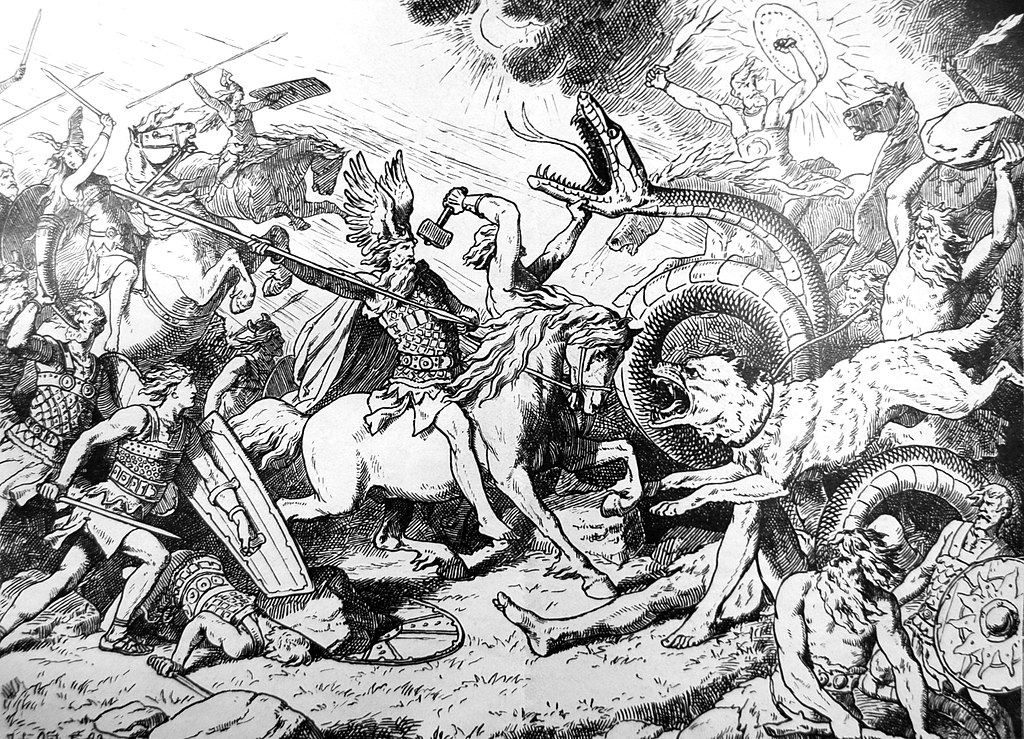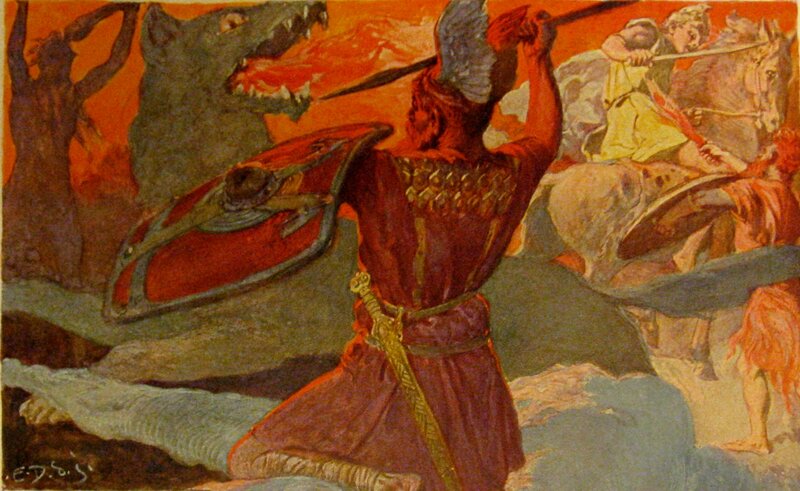The story of Ragnarök is a prophecy about the end of the world in Scandinavian legend. It foretells a huge final battle resulting in the death of gods, men, giants, and monsters. In some later versions of the Norse myth, there are some survivors, and the pantheon and humans repopulate after the events in a much-changed new world.
Ragnarök: Meaning Behind the Word
Ragnarök or (Ragnarok) means “Doom” or “Fate of the Gods” in Old Norse.
Some texts call it “Aldar Rök,” or “fate of mankind,” and “Ragnarøkkr,” or “Twilight of the Gods.”
Richard Wagner’s opera Götterdämmerung also means “twilight of the gods” in German.
What Causes Ragnarök in Norse Mythology?
There are descriptions of incidents preceding Ragnarök from stanza 40 of Völuspá from the Poetic Edda.
Odin is questioning a völva or soothsayer who starts to prophesize about how the end of the world will begin.
She describes how three cockerels will crow: the golden Gullinkambi, the bright red Fjalar, and an unnamed dirty-red one in Hel. This crowing will accompany the playing of a harp by the wolf-breeder Eggthér from Jotunheim. Garm, the hound-wolf, will howl in his cave before breaking his chain and escaping.
Chapter 51 of Gylfaginning in the Prose Edda by the Icelandic politician, historian, and poet Snorri Sturluson provides more preceding events of Ragnarök and some indications of the ensuing chaos.
Hár (one of Odin’s many aliases) talks about three major winter battles characterized by greed, causing families to fall apart and kill one another. Fimbulwinter (or Fimbulvetr), a period of three years of endless winter and hardly any sun, will follow these conflicts.
Heimdall will sound Gjallarhorn to announce the beginning of Ragnarök.
What Happens During Ragnarök?
Chapters 52 and 53 go into detail about how the cataclysmic events unfold. They incorporate several quotes from Völuspá (or “Sibyl’s Prophecy”), the best-known poem in the Poetic Edda.
Hati and Sköll, the two giant wolf brothers, will catch and devour the keepers of the Sun and the Moon, Sol, and Mani, making the stars disappear. Violent storms and earthquakes will make even the world tree Yggdrasil shake. The chains restraining the monstrous wolf Fenrir, son of Loki, will break, setting the beast free.
The shock waves cast the ship Naglfar (“ship of human nails”) out over the flooded lands. The giant Hrym will steer the boat, and its captain is Loki, now free from the entrails of his son, which bound him as punishment for engineering the death Baldr.

Jörmungandr, Fenrir and Surt
Another son of Loki, the Midgard serpent Jörmungandr, which surrounds the realm of humans, submerged in the ocean, will rise and spray venom across the land and sea. Fenrir will devour everything in his path, his upper jaw touching the heavens and his lower jaw the earth.
The sky will part, and the fire giants from Muspelheim will appear through the cracks. Their leader Surtr, with his flaming sword, will lead them into Asgard across the rainbow bridge Bifrost, which will collapse behind them.
Odin requests the severed head of Mimir to provide him with counsel, and he and the other gods decide to meet their opponents in battle, even knowing it is their destiny to die. They choose the field of Vigrid (Old Norse for “Battlefield”) as the battleground.
The Æsir, the Einherjar, and the death of gods
The Æsir fight side-to-side with the Einherjar, the host of dead warriors from Valhalla. Fenrir eats Odin whole before one of his sons, Vidar, wearing a magic shoe that helps him to hold the wolf’s mouth open, kills the wolf by driving his sword through its throat.
God of war, Tyr and Garm, the wolf guardian of Hel, fight and kill each other, as do Heimdall and the trickster god Loki. Without his magic sword, Freyr is killed by Surtr, although Freyr inflicts a mortal wound on the fire-giant god with an antler.
Thor kills Jörmungandr with his hammer Mjölnir, but the poisonous serpent has bitten him, and he too dies after taking nine steps.

Who Wins Ragnarök in Norse mythology?
Neither side won as both lost their most important characters.
Four principal gods perished (Odin, Thor, Freyr, and Tyr), while five monsters or evil gods died on the other side (Loki, Fenrir, Jörmungandr, Surtr, and Garm).
Norse Gods and Monsters’ destiny in Ragnarök
| Killed in Ragnarök | Ragnarök Survivors |
| Odin, killed by Fenrir | Frigg, wife of Odin |
| Thor, killed by Jörmungandr (and vice versa) | Freyja and Njord, sister and father of Freyr |
| Loki, killed by Heimdall (and vice versa) | Vidar and Váli, sons of Odin |
| Tyr, killed by Garm (and vice versa) | Móði and Magni (Thor’s sons; Magni inherits Mjölnir) |
| The Vanir god Freyr, killed by Surtr (and vice versa) | Baldr and Hodr (who return from Hel, the land of the dead) |
| The wolf Fenrir, killed by Vidar (son of Odin) | Hel (at least no mention is made of her death) |
| Mani and Sol, killed by Sköll and Hati | Lif and Lifthrasir (“Life” and “Vitality” – a mortal man and woman who repopulate humankind) |
What Happens After Ragnarök?
Although some versions do not mention events after Ragnarök, some later texts do. They describe the earth rising again, cleansed and fertile, although some areas are still foul and dangerous. Baldr and his brother Hodr return from Hel. Those people who are worthy will live in a hall with a golden roof.
A man and woman, Lif and Lifthrasir, emerge from their hiding place known as Hoddmímis holt, considered to be Yggdrasil or the World Tree. Their destiny is to start the repopulation of humanity.
Interesting fact
Ragnarök Viking tattoos are quite popular and this article has a particularly useful account of the significance of Ragnarök tattoos.

